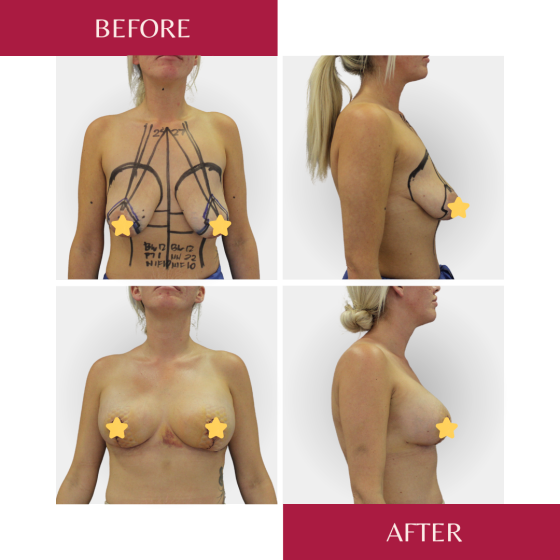Procedure in numbers
Other plastic surgeries
You could be interested in…
All about procedure
Breasts uplift (mastopexy) is the method of choice in case of drooping breasts, while breasts are additionally small surgery involving the use of breast implants. If the breasts are large and drooping, breast reduction should be considered.
Mastopexy beside of breast augmentation is one of the most popular treatments in the field of plastic surgery. It is used in many cases, including:
- sagging breasts with excess of loose skin
- small and sagging breasts because of mammary gland atrophy
- asymmetry of breasts
Breast uplift is indicated for women after pregnancy, who lost lots of weight and suffer imbalances or breasts size and its loss of volume with stretched skin.
SILICONE IMPLANTS
Breast augmentation uses various types of breast prostheses. They differ in size, shape, profile and material from which they are made. The most common implants are prostheses filled with medical silicone gel (Cohesive gel). The advantage of medical silicone is that it is inert or neutral to the body. This means that it does not cause allergic reactions or the formation of an inflammatory process. Modern breast prostheses have an improved surface – it is rough, which makes it difficult for the body to create a painful, hard fibrotic changes around them. Breast implants do not interfere with maternity plans – they allow undisrupted breastfeeding.
PREPARING FOR THE TREATMENT
METHODOLOGY OF THE TREATMENT
POST-OPERATIVE RECOMMENDATIONS
POSSIBLE COMPLICATIONS
CONTRAINDICATIONS FOR THE TREATMENT
PRICES
DOCUMENTS
PREPARING FOR THE TREATMENT
Each breast augmentation procedure is performed under general anesthesia. A patient deciding on this type of surgery should have the following tests performed a maximum of 10 days before surgery:
- blood group
- morphology
- blood coagulation factors (APTT / INR)
- creatinine level
- glucose level electrolytes (Na-sodium, K-potassium)
An anesthesiological interview is conducted immediately before the procedure and an interview with an anesthesiologist during which the patient can learn all aspects of general anesthesia. About two weeks before surgery, smoking should be stopped – it has a significant impact on the wound healing process. You should also avoid taking medicines that thin the blood, e.g. aspirin. On the day of the operation, do not eat or drink beverages (including water) for a minimum of 6 hours before surgery.
METHODOLOGY OF THE TREATMENT
There is a number of techniques for a breast lift and mostly differ in the location of incision which are dictated by the size of the breast and the volume of sagging skin. They way of making breast uplift and incisions you will discuss with surgeon during your examination which will verify your skin type. The most common techniques are:
Donut lift (Benneli technique – peri-areolar incision)
In case there is more moderate sagging surgeon might recommend a donut lift. There’s only one incision made, as a circle around areola, so the scar is minimized. This kind of breast uplift is usually made in conjunction with a breast augmentation. The additional benefit is reduced size of the areola. Because of this, the procedure is also called a peri-areolar lift.
Lollipop lift
This technique of lift is dedicated for patients who would like to do reshaping while also correcting any sag. Surgeon is doing two incisions in each breast to help remove extra skin and reshape them. One incision is made from the bottom of the areola to the crease below the breast and second one is done around the areola, hence the “lollipop” shape comes from.
Anchor lift
For patient who have significant sagging breasts, surgeon will recommend an anchor lift. On one side this type of lift involves the greatest degree of scars, but one the other hand brings the most significant results of sagging breasts and reshaping them the most. This kind of breast uplift is usually made in conjunction with a breast augmentation under the muscle. Surgeon is doing one horizontal incision along the breast crease, the other one is in between the crease and the areola. There is also one around the areola edge and additional benefit is reduced size of the areola.
During anchor lift putting of implant thru the fold under the breast offers easy access to create a pocket in which the implant will be placed, and low visibility of the scar after healing. The implant can be placed under the gland or under the muscle. The implant placement depends on the initial appearance of the breast. An important aspect regarding breast augmentation during uplift surgery is a significant loss of firmness. The patient after the procedure remains in the clinic under the care of medical staff.
POST-OPERATIVE RECOMMENDATIONS
On day 1 after the procedure, special drains which prevent fluid accumulation at the implant site are removed. Immediately after the procedure, the patient is dressed in a specially fitted compression bra, which is to prevent the implant from sliding and the formation of edema. Breast soreness after surgery depends on the patient’s predisposition and ,if necessary, she is given painkillers. For 10-12 weeks after surgery, you should keep wearing a compression bra, both during the day and at night. The recovery time depends on the patient’s body, and the final effect of the treatment is usually obtained from 6-9 months after the surgery.
POSSIBLE COMPLICATIONS
CONTRAINDICATIONS FOR THE TREATMENT
- poor blood test results,
- unregulated blood pressure,
- unregulated diabetes,
- unknown breast tumors,
- cancer,
- pregnancy,
- breastfeeding,





